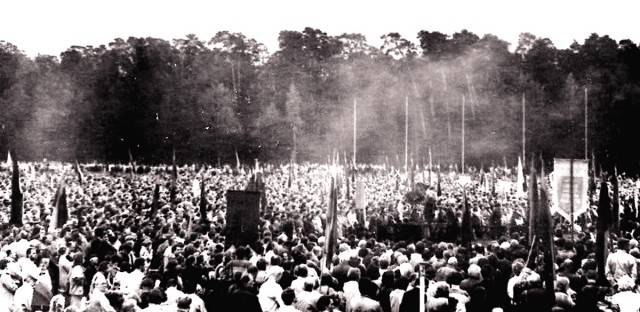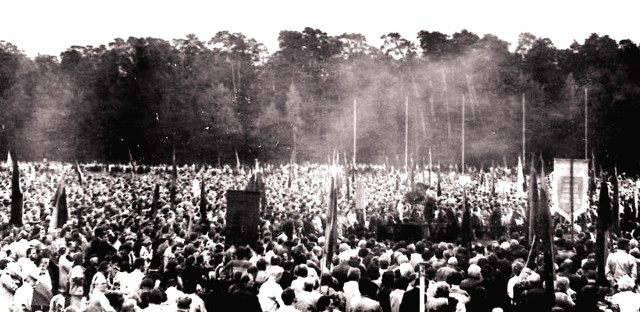
This photograph shows an anti-Soviet rally in Vingis Park of about 250,000 people. Sajudis was a movement which led to the restoration of an independent state of Lithuania.
Lithuania had been part of the Soviet Union since 1939. Lithuanians complained long and loud about this absorption, but to no avail. Following World War II, Soviet forces did not withdraw and the United States made little effort to support Lithuanian independence. There matters stood until 1985 and the rise of Mikhail Gorbachev as leader of the Soviet Union. In 1989, as part of his policy of loosening political repression in the Soviet Union and improving relations with the West, Gorbachev repudiated the Brezhnev Doctrine of 1968, which stated that the Soviet Union was justified in using force to preserve already existing communist governments. Lithuanian nationalists took the repudiation of the Brezhnev Doctrine as a signal that a declaration of independence might be accepted.
On March 11, 1990, Lithuania declared that it was an independent nation, the first of the Soviet republics to do so. It had, however, overestimated Gorbachev’s intentions. The Soviet leader was willing to let communist governments in its satellites fall to democratic movements, but this policy did not apply to the republics of the Soviet Union. The Soviet government responded harshly to the Lithuanian declaration of independence and issued an ultimatum: renounce independence or face the consequences. On March 17, the Lithuanians gave their answer, rejecting the Soviet demand and asking that “democratic nations” grant them diplomatic recognition.

The Soviets had not been bluffing. The Soviet government insisted that it still controlled Lithuania, Gorbachev issued economic sanctions against the rebellious nation, and Soviet troops occupied sections of the capital city of Vilnius. In January 1991, the Soviets launched a larger-scale military operation against Lithuania. Many in the United States were horrified, and the U.S. Congress acted quickly to end economic assistance to the Soviet Union. Gorbachev was incensed by this action, but his powers in the Soviet Union were quickly eroding. In December 1991, 11 of the Soviet Socialist Republics proclaimed their independence and established the Commonwealth of Independent States. Just a few days after this action, Gorbachev resigned as president and what was left of the Soviet Union ceased to exist.

Lithuania had been part of the Soviet Union since 1939. Lithuanians complained long and loud about this absorption, but to no avail. Following World War II, Soviet forces did not withdraw and the United States made little effort to support Lithuanian independence. There matters stood until 1985 and the rise of Mikhail Gorbachev as leader of the Soviet Union. In 1989, as part of his policy of loosening political repression in the Soviet Union and improving relations with the West, Gorbachev repudiated the Brezhnev Doctrine of 1968, which stated that the Soviet Union was justified in using force to preserve already existing communist governments. Lithuanian nationalists took the repudiation of the Brezhnev Doctrine as a signal that a declaration of independence might be accepted.
On March 11, 1990, Lithuania declared that it was an independent nation, the first of the Soviet republics to do so. It had, however, overestimated Gorbachev’s intentions. The Soviet leader was willing to let communist governments in its satellites fall to democratic movements, but this policy did not apply to the republics of the Soviet Union. The Soviet government responded harshly to the Lithuanian declaration of independence and issued an ultimatum: renounce independence or face the consequences. On March 17, the Lithuanians gave their answer, rejecting the Soviet demand and asking that “democratic nations” grant them diplomatic recognition.

The Soviets had not been bluffing. The Soviet government insisted that it still controlled Lithuania, Gorbachev issued economic sanctions against the rebellious nation, and Soviet troops occupied sections of the capital city of Vilnius. In January 1991, the Soviets launched a larger-scale military operation against Lithuania. Many in the United States were horrified, and the U.S. Congress acted quickly to end economic assistance to the Soviet Union. Gorbachev was incensed by this action, but his powers in the Soviet Union were quickly eroding. In December 1991, 11 of the Soviet Socialist Republics proclaimed their independence and established the Commonwealth of Independent States. Just a few days after this action, Gorbachev resigned as president and what was left of the Soviet Union ceased to exist.


